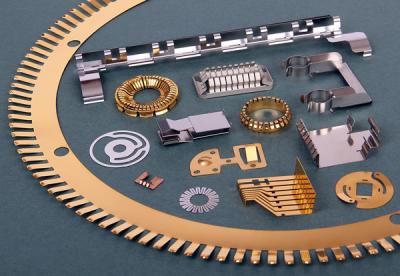
Tech-Etch, Plymouth, Mass., which specializes in the etching, forming, heat treating and finishing of components made from metals with superior spring characteristics, offers prototypes delivered in 5 days.
Visit the company’s website for a “Precision Engineered Parts Capabilities” brochure or to contact an engineer if you have a technical question about spring metals.
According to Tech-Etch:
- MP35N is an ultra high tensile strength metal with good ductility and excellent corrosion resistance used for medical implants.
- Elgiloy has high strength, ductility, fatigue life and is corrosion resistant in numerous environments. It is ideal for stiffener bands and spring energized seals.
- Beryllium Copper has excellent conductivity for battery contact, ground spring and EMI/RFI shielding applications. It can be formed with sharp bends and heat treated for optimum spring properties.
- Stainless steels are selected for their corrosion resistance, fatigue strength, toughness, and surgical implant suitability. Varieties include 300 and 400 series, hardened and tempered, flapper valve grade, razor blade grade, and precipitation hardened grade.
- Nitinol is a shape memory alloy with very good electrical and mechanical properties, long fatigue life, and high corrosion resistance for stents and retaining springs.
- Phos Bronze has good conductivity and cold workability for clutch springs, diaphragms, and contact springs.
Contact Details
Related Glossary Terms
- corrosion resistance
corrosion resistance
Ability of an alloy or material to withstand rust and corrosion. These are properties fostered by nickel and chromium in alloys such as stainless steel.
- ductility
ductility
Ability of a material to be bent, formed or stretched without rupturing. Measured by elongation or reduction of area in a tensile test or by other means.
- fatigue
fatigue
Phenomenon leading to fracture under repeated or fluctuating stresses having a maximum value less than the tensile strength of the material. Fatigue fractures are progressive, beginning as minute cracks that grow under the action of the fluctuating stress.
- fatigue life
fatigue life
Number of cycles of stress that can be sustained prior to failure under a stated test condition.
- fatigue strength
fatigue strength
Maximum stress that can be sustained for a specified number of cycles without failure, the stress being completely reversed within each cycle unless otherwise stated.
- mechanical properties
mechanical properties
Properties of a material that reveal its elastic and inelastic behavior when force is applied, thereby indicating its suitability for mechanical applications; for example, modulus of elasticity, tensile strength, elongation, hardness and fatigue limit.
- stainless steels
stainless steels
Stainless steels possess high strength, heat resistance, excellent workability and erosion resistance. Four general classes have been developed to cover a range of mechanical and physical properties for particular applications. The four classes are: the austenitic types of the chromium-nickel-manganese 200 series and the chromium-nickel 300 series; the martensitic types of the chromium, hardenable 400 series; the chromium, nonhardenable 400-series ferritic types; and the precipitation-hardening type of chromium-nickel alloys with additional elements that are hardenable by solution treating and aging.
- tensile strength
tensile strength
In tensile testing, the ratio of maximum load to original cross-sectional area. Also called ultimate strength. Compare with yield strength.
